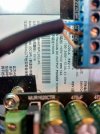We don't know the relationship values between the input voltage and the power supply output rails supplying the output amp power. Measurements would be req'd to get those details. Otherwise for the rails these are the parameters req'd:just for studying purpose have been reading TPA3255 datasheet. LINK. With various implementations and varying power supply voltages and amps, am finding it little confusing. Though at 51V it achieves (~100W, 8 ohms approx. 0.1% thd) It seems those voltages can be lowered to be on safe side and for longetivity of the chip as 51v is maximum.
So what would be ideal power supply requirement (volts and amps) to have 0.1 % distortion(Standard i suppose) and what maximum watts (in to 8 ohms and 4 ohms) one would get with those safe side voltages ?
thanks.
8R @ 140 Watts RMS @ 0.1% THD = rail voltage req'd @ 47.3 VDC
4R @ 240 Watts RMS @ 0.1% THD = rail voltage req'd @ 43.8 VDC
- The pdf does not state if the amp output power is peak or RMS so I am supplying both here -
8R @ 140 Watts @ 0.1% THD = rail voltage req'd @ 33.5 VDC
4R @ 240 Watts @ 0.1% THD = rail voltage req'd @ 31 VDC


